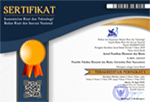FAKTOR-FAKTOR PENENTU DANA PIHAK KETIGA BANK UMUM SYARIAH DI INDONESIA TAHUN 2010-2017
DOI:
https://doi.org/10.33633/jpeb.v4i2.2552Abstract
Perkembangan dana pihak ketiga (DPK) Bank Umum Syariah (BUS) cenderung meningkat setiap tahun. Peningkatan ini diharapkan relevan dengan peningkatan kinerja keuangan usahanya. Penelitian ini bertujuan untuk menganalisis faktor-faktor yang mempengaruhi dana pihak ketiga Bank Umum Syariah di Indonesia pada tahun 2010-2017. Metode analisis data menggunakan data panel dengan Random Effect Model (REM). Metode ini dipilih sebagai model terbaik berdasarkan Uji Chow, Uji Hausman, dan Uji Lagrange Multiplier. Data penelitian ini terdiri atas time series sebanyak 8 tahun dan cross section sebanyak 10 BUS. Sumber data penelitian diperoleh dari Bank Indonesia (BI) dan Otoritas Jasa Keuangan (OJK). Variabel independen dalam penelitian ini adalah bagi hasil, biaya promosi, dan jumlah kantor layanan. Hasil penelitian ini menunjukkan bahwa selama periode penelitian bagi hasil, jumlah kantor layanan, dan biaya promosi berpengaruh positif dan signifikan terhadap DPK BUS. Selain itu, hasil uji koefisien determinasi (R2) yaitu sebesar 0.869811. Hal tersebut menunjukkan bahwa sebesar 86.9811% variasi variabel dependen dijelaskan oleh variasi variabel independen. Untuk itu, BUS dapat mengkaji ulang penetapan tingkat bagi hasil, biaya promosi dan jumlah kantor layanan untuk mendorong capaian dana pihak ketiga secara progresif.References
Gujarati, D. N. & Porter, D. C. 2009. Basic Econometric 5thEdition. New York : McGraw –Hill.
Hilman, I. 2016. The Factors Affecting Mudharabah Deposits of Sharia Banking in Indonesia. International Journal of Business and Management Invention, 5, 8, 56-66. http://www.ijbmi.org/papers/Vol(5)8/version-3/G0583056066.pdf
Kishada, Z. M.E.M. & Wahab, N. A. 2013. Factors Affecting Customer Loyalty in Islamic Banking: Evidence from Malaysian Banks. International Journal of Business and Social Science, 4, 7, 264-273. http://ijbssnet.com/journals/Vol_4_No_7_July_2013/29.pdf
Lisa, O. 2016. Analysis of Effect of Capital Structure, Company Size and Distribution of Funds against Third Party Financing and Its Implication on Profitability (Studies in Islamic Cooperative Baitul Maal Tamwil in Indonesia). International Journal of Finance and Accounting, 5, 3, 158-164. DOI: 10.5923/j.ijfa.20160503.03
Mobin, M. A. & Masih, M. 2014. Do the Macroeconomic Variables have any Impact on the Islamic Bank Deposits? An Application of ARDL Approach to the Malaysian Market. MPRA Paper No. 623342 February. https://mpra.ub.uni-muenchen.de/62342/
Mumtazah, W. & Septiarini, D. F. 2016. Analisis Faktor-Faktor yang Mempengaruhi Jumlah Dana Pihak Keriga Pada Bank Umum Syariah di Indonesia (Periode Triwulan I 2010 – Triwulan 1 2015). Surabaya : Universitas Airlangga.
Novianto, A. S. & Hadiwidjojo, D. 2013. Analisis Faktor-Faktor yang Mempengaruhi Penghimpunan Deposito Mudharabah Perbankan Syariah di Indonesia. Jurnal Aplikasi Manajemen, 11, 4, 595-604. https://jurnaljam.ub.ac.id/index.php/jam/article/viewFile/596/614
Prasetya, B., Tan, S. & Delis, A. 2015. Faktor-Faktor yang Mempengaruhi Penghimpunan Dana Pihak Ketiga Perbankan Syariah di Indonesia. Jurnal Perspektif Pembiayaan dan Pembangunan Daerah, 3, 2, 91-100. https://www.online-journal.unja.ac.id/JES/article/view/3502
Prasetyoningrum, A. K. 2015. Analysis BI Rate and Return of Third Party Fund on Rate of Third Party Fund on Islamic Banking in Indonesia. Conference In Business, Accounting, And Management (CBAM), 2, 1, 104-116. http://jurnal.unissula.ac.id/index.php/cbam/article/view/296
Saini, Y., Bick, G. & Abdulla, L. 2011. Consumer Awareness and Usage of Islamic Banking Products in South Africa. SAJEMS, 14, 3, 298-313. http://www.scielo.org.za/pdf/sajems/v14n3/v14n3a04.pdf
Sari, I. M., Wibowo, H. & Suprapto, E. 2015. Factors that Influenced People to Become Islamic Bank Customer: A Study on Kancana Villagers. Al-Iqtishad, VII, 1, 73-86. http://journal.uinjkt.ac.id/index.php/iqtishad/article/view/1360/1201
Sudarsono, H. 2009. Dampak Krisis Keuangan Global terhadap Perbankan di Indonesia: Perbandingan antara Bank Konvensional dan Bank Syariah. Jurnal Ekonomi Islam La Riba, III, 1, 12-23. https://journal.uii.ac.id/JEI/article/view/2551/2339
Undang-undang No. 21 Tahun 2008 tentang Perbankan Syariah.
Wulandari, S. & Siti, A. 2014. Analisis Faktor Internal dan Eksternal Yang Mempengaruhi Total Dana Pihak Ketiga (DPK) Bank Umum Syariah di Indonesia (Studi pada Bank Umum Syariah Periode 2011-2013). Malang: Universitas Brawijaya.
Yanti, E. M., Arfan, M. & Basri, H. 2018. The Effect of Third Party Funds, Financing to Deposit Ratio and Non Performing Financing toward Financing and its Impact on Profitability of Indonesian Sharia Banking (Studies at Sharia Commercial Banks Period 2011-2015). Account and Financial Management Journal, 3, 01, 1240-1246. DOI:10.18535/afmj/v3i1.03
Yulianto, A. & Solikhah, B. 2016. The Internal Factors of Indonesian Sharia Banking to Predict the Mudharabah Deposits. Review of Integrative Business & Economics Research, 5, 1, 210-218. http://buscompress.com/uploads/3/4/9/8/34980536/riber_h15-125__210-218_.pdf
Downloads
Published
How to Cite
Issue
Section
License
The copyright of the received article shall be assigned to the journal as the publisher of the journal. The intended copyright includes the right to publish the article in various forms (including reprints). The journal maintains the publishing rights to the published articles.
This work is licensed under a Creative Commons Attribution 4.0 International License.



.png)









